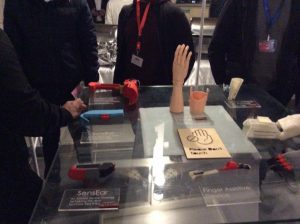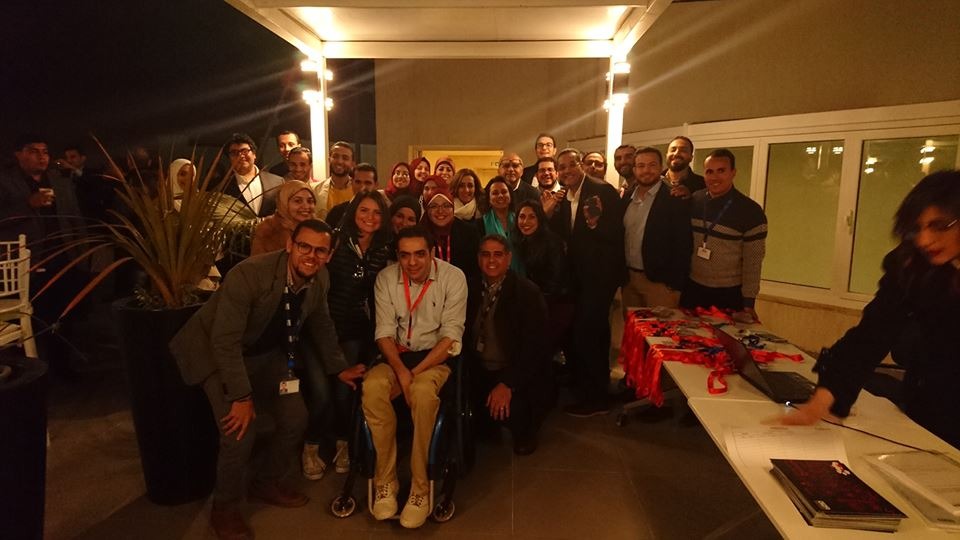In 2016, Mohamed El-Hossary and Ahmed Mohsen were running a 3D printing service and marketplace called Etba3ly. When they decided to attend a Maker Faire, things changed for them. At the faire, El-Hossary met Jon Schull, CEO of e-NABLE, which famously makes 3D printed prosthetic hands for those in need around the world. The meeting made El-Hossary and Mohsen realize that there were thousands of people in Egypt who needed prosthetics and were unable to access them. Mohsen’s own father, in fact, owned a wood factory where workers sometimes sustained serious injuries to their hands and arms.
Schull pointed out how easy it was to create prosthetics using the equipment that El-Hossary and Mohsen already had at Etba3ly. Excited, they decided to open an Egyptian branch of e-NABLE, testing their first prosthetic hand on an engineer who volunteered to act as a trial subject. The device was a success, and the two Etba3ly founders began making more prosthetics.
 Once word got out about what El-Hossary and Mohsen were doing, organizations such as NGOs, charities and student organizations began reaching out to help support the project. In late 2017, Giza Systems recognized the project, and a few months later, Project Nitrous was born, an organization to support and boost the work being done for people with disabilities (PwDs).
Once word got out about what El-Hossary and Mohsen were doing, organizations such as NGOs, charities and student organizations began reaching out to help support the project. In late 2017, Giza Systems recognized the project, and a few months later, Project Nitrous was born, an organization to support and boost the work being done for people with disabilities (PwDs).
The key to Project Nitrous is that it empowers people with disabilities by making them part of the development process for their own assistive devices.
“Of course, not everyone wants to learn these skills and are interested in the digital fabrication steps, but we still serve them just the same,” said Project Nitrous engineer Islam Mohamed. “Helping the people is only one of our two objectives.”
The project is not without its challenges. Paperwork, legality and imports had to be dealt with – the 3D printers and supplies used for the project often get stuck in customs for months. There are also class issues that make it harder for the founders to reach those in need.
“It’s sufficient to say that it’s already hard for the PwDs to cross the highway road to reach our premises, so we have to hop in our cars to get them, let alone the other residence and logistical issues that arise as well,” said El-Hossary. “Ahmed Said, one of our engineers, had to meet with one of the PwD at a local cafe because transportation was too expensive for the PwD.”
Sometimes the people that the organization work with are full of doubt that Project Nitrous can be any help to them.
“They [PwDS] have been promised countless times by senior engineering students that their graduation projects will change their lives, and in the end, the PwD is extremely disappointed, and long forgotten,” said Esraa Mahmoud, the Community Outreach specialist. “Most people we reach out to are skeptical that we can help them. They too often tell us ‘you are like the senior Engineering Students who claim they can help us but forget about us once they are done with their graduation projects,’ so we understand where their doubt is coming from.”
Sometimes there are further communication issues when a spokesperson is designated to relay the needs of a person with disabilities.
“In order to design a suitable tool for the PwD, we have to talk to the person himself/herself, and listen to their needs first-hand,” Mahmoud continued. “We can’t find a solution if the person-in-contact won’t allow us to speak the PwD we are designing the tool for.”
Despite the difficulties, however, the people of Project Nitrous consider what they’re doing to be more than worth it.
“One of the people we were working with mentioned that he was facing difficulty tying the buttons of his shirt right before he left our lab after hours of working with him, so without much thinking, we gave him a kit that we had already designed for that specific function,” said Mahmoud.
The next day, the man called to thank Project Nitrous and to express his joy.
“We changed his life by helping him tie the buttons of his shirt,” said Mohamed.
Project Nitrous is extending its work into four main tracks:
- Creating assistive devices
- Giving people with disabilities the technical knowledge to design their own tools
- Creating a startup extension of the project run by people with disabilities
- Providing a blueprint for others who want to start similar businesses and creating an open-source community where designs and tools are accessible to all
Project Nitrous was officially born in February 2018, and has helped 23 people so far, with 18 additional projects currently in progress. The stories are varied, but all result in people being able to do things they weren’t able to do before, from buttoning the buttons on a shirt to returning to school to continue education.
Discuss this and other 3D printing topics at 3DPrintBoard.com or share your thoughts below.
[Source: Egyptian Streets/Images: Project Nitrous]
Subscribe to Our Email Newsletter
Stay up-to-date on all the latest news from the 3D printing industry and receive information and offers from third party vendors.
You May Also Like
3D Printing Unpeeled: New Arkema Material for HP, Saddle and Macro MEMS
A new Arkema material for MJF is said to reduce costs per part by up to 25% and have an 85% reusability ratio. HP 3D HR PA 12 S has been...
3D Printing News Briefs, January 20, 2024: FDM, LPBF, Underwater 3D Printer, Racing, & More
We’re starting off with a process certification in today’s 3D Printing News Briefs, and then moving on to research about solute trapping, laser powder bed fusion, and then moving on...
3D Printing Webinar and Event Roundup: December 3, 2023
We’ve got plenty of events and webinars coming up for you this week! Quickparts is having a Manufacturing Roadshow, America Makes is holding a Member Town Hall, Stratafest makes two...
Formnext 2023 Day Three: Slam Dunk
I’m high—high on trade show. I’ve met numerous new faces and reconnected with old friends, creating an absolutely wonderful atmosphere. The excitement is palpable over several emerging developments. The high...

































